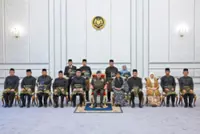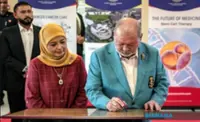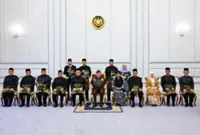The urban growth of Iskandar Puteri, renamed Johor Baru, significantly advanced after 1855, transforming it into a modern city with a well-organised administration.
THE JOHOR Sultanate is fundamentally built upon three main dynasties: the Melaka Sultanate Dynasty, the Bendahara Dynasty and the Temenggong Dynasty.
Founded in 1528, the Johor Sultanate was a direct offshoot of Melaka, profoundly influencing Johor’s governance, culture and traditions.
“This rich heritage is a fusion of Malay royal customs, Bugis influences, and Riau-Malay ethnicity, creating a unique and vibrant cultural identity,” said senior lecturer at the Universiti Malaya History Department Dr Mardiana Nordin.
She added that all three dynasties shared the same sovereignty, with the Bendahara and Temenggong houses also being part of the royal lineage in the Malay Sultanate.
Historical lineage of His Majesty Sultan Ibrahim, King of Malaysia
The Temenggong Dynasty started when the sovereignty and right to govern Johor (excluding Muar-Kesang district) was acquired by Temenggong Daeng Ibrahim from Sultan Ali, who was of the Bendahara Dynasty, in 1855.
“Temenggong Daeng Ibrahim had several children, including Tun Abu Bakar, who took over governance after Daeng Ibrahim’s death in 1862.
“Tun Abu Bakar then adopted the title Sultan Abu Bakar on Dec 11, 1885,” Mardiana added.
Sultan Abu Bakar’s heir – Sultan Ibrahim (Tunku Ibrahim Abu Bakar) – ascended the throne on June 4, 1895, after his death.
Sultan Ibrahim was then succeeded by Tunku Ismail, who took the title as Sultan Ismail on May 8, 1959.
“Sultan Ismail’s notable wives included Sultanah Tun Aminah binti Ungku Ahmad and Sultanah Nora binti Tengku Ahmad (from the Kelantan royal family).
“Sultan Ismail’s children included Tunku Mahmood Iskandar, Tunku Bendahara Tunku Abdul Rahman and Tunku Tun Maimunah.
“He also had several children who passed away young: Tunku Abdul Jalil, Tunku Khalsom and Tunku Abdul Rahman,” Mardiana said, citing historical sources.
After the death of Sultan Ismail, Tunku Mahmood Iskandar was proclaimed Sultan Iskandar on May 11, 1981.
Sultan Iskandar was the father of the current Johor Ruler – His Majesty Sultan Ibrahim, King of Malaysia.
“Sultan Ibrahim, ascended the throne in 2010 after Sultan Iskandar’s passing. He is the son of Sultan Iskandar and Che Khalsom Abdullah.
“Sultan Ibrahim and his wife, Raja Zarith Sofiah (a princess from the Perak royal family), have five sons and one daughter: Tunku Mahkota Johor Tunku Ismail, Tunku Tun Aminah Maimunah Iskandariah, Tunku Temenggong Johor Tunku Idris Iskandar, Tunku Laksamana Johor Tunku Abdul Jalil (passed away in 2015), Tunku Panglima Johor Tunku Abdul Rahman and Tunku Putera Johor Tunku Abu Bakar,” Mardiana said.
The Johor State Constitution: A beacon for other states
Mardiana noted that a significant milestone in Johor’s history was the formulation of the Johor State Constitution on April 14, 1895, which became a reference point for other states in drafting their laws.
“Originally written in Malay using Jawi script, it was later translated into Romanised script and subsequently into English.
“This legal framework solidified the sovereignty of the royal family, safeguarding their position and outlining clear rules for the appointment of the Sultan, heirs, Tunku Mahkota and Permaisuri, among others,” she added.
She said among notable aspects of the Constitution is Clause 7(2) in Part Two, which grants the Sultan the authority to amend, enhance and enrich Malay customs practised in Johor.
“This clause highlights the Sultan’s commitment to cultural preservation while allowing the evolution of Johor’s unique identity,” the academician said.
Economic progress: Trade and agriculture
Johor’s economic development was also rooted in the ancient days of Melaka, particularly its role as an international trade hub.
From the 16th century onwards, Johor’s capitals along the Johor River such as Johor Lama, Kota Tinggi, Seluyut and Panchur, emerged as significant international trading ports.
This tradition continued in Riau during the 18th century before shifting to Iskandar Puteri (Johor Baru) in 1855.
During the 16th and 17th centuries, Johor successfully competed with the Portuguese in Melaka and Aceh.
“Johor Lama, for instance, was a renowned entrepot during this era. This attracted Dutch collaboration, leading to treaties in 1639 and 1640 that later helped to overthrow the Portuguese in Melaka.
“But growing tensions with the Dutch in the 18th and 19th centuries were due to Johor’s resistance to Dutch dominance in the Malay archipelago,” said Mardiana.
With the rise of the Temenggong Dynasty, Johor became more active in agriculture, benefiting from astute rulers who fostered cooperation with foreign powers, particularly the British and Chinese.
Mardiana said innovations like the Kangchu system promoted the cultivation of black pepper and gambier, alongside other crops such as rubber, coffee and pineapple.
The urban growth of Iskandar Puteri, renamed Johor Baru, significantly advanced after 1855, transforming it into a modern city with a well-organised administration.
The Coronation and symbols of Johor
Johor introduced a comprehensive set of regalia during the coronation ceremony of Sultan Abu Bakar’s son, Tunku Ibrahim Iskandar, as the Crown Prince of Johor on May 23, 1891.
Citing historical sources, Mardiana said Sultan Abu Bakar conceived the idea and created these ceremonial items in 1886 to replace remnants of regalia inherited from the Johor Sultanate in Riau.
“These items included the Personal Royal Standard and the State Flag, the sceptres of Religion and the Universe, the Keris Darjah Kerabat and Keris Darjah Mahkota, one mace, four umbrellas, 16 spears and eight staves,” she said.
This also included the state anthem Selamat Sultan, she said, which was first played when Sultan Abu Bakar ascended the throne.
“Initially, in 1891, the anthem lacked lyrics. It wasn’t until 1910 that lyrics were composed and the song became known as Lagu Bangsa Johor,” she added.
Unlike the other Sultanates of other states, which use the royal headgear adorned with the Sultan’s personal emblem as part of their coronation attire, Johor has its unique symbol – the Johor Crown.
Following the Anglo-Johor Treaty 1885 (The Johor-British agreement signed in London), Sultan Abu Bakar was inspired to create a royal crown to elevate the dignity, respect and sovereignty of the monarchy.
The Johor Crown also became a symbol of material renewal, indicating that Johor was a modern and civilised state.
“This bold move signified a significant shift in royal ceremonial attire at the time,” said Mardiana, adding that the crown was inspired by King Edward’s crown but was modified to suit Sultan Abu Bakar’s taste.
“For example, the cross symbol was replaced with a crescent moon and a five-pointed star. The words ‘Allah’ and ‘Muhammad’ were also incorporated.
“Alongside this, a diadem for the Royal Consort was also designed and produced,” added Mardiana.







